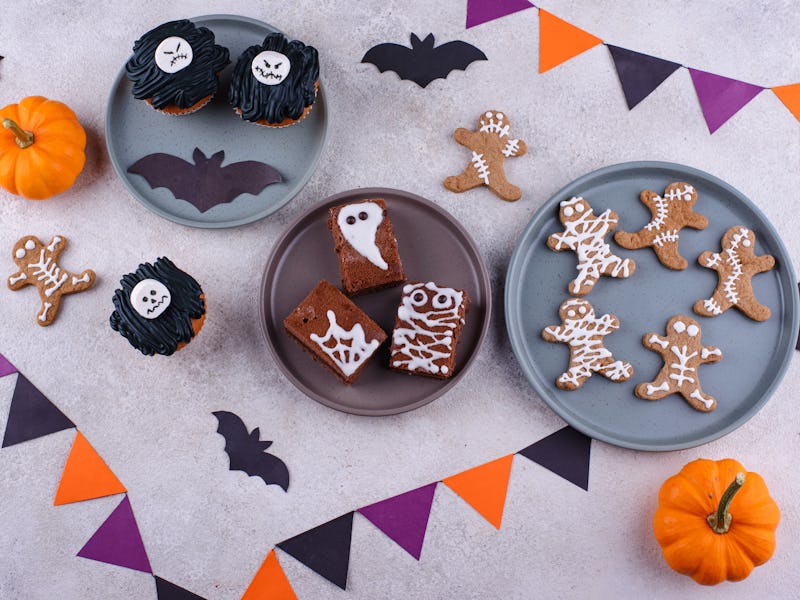Why do we eat candy on Halloween? A holiday historian indulges in the surprising answer
Bribery beats arson.

The second-best day of the year to buy candy is Halloween; the best day is November 1 (tied with February 15). But why do we eat candy on Halloween in the first place? What does candy have to do with being scared or seeing ghosts?
Halloween historian and writer Lisa Morton indulges in the history behind the tradition.
Why do we eat candy on Halloween?
So, how are Snickers and Milky Ways relevant to a good fright? Well, nothing is scarier than the destruction of private property. One might associate Halloween with Mischief Night (or Goosey Night if you hail from a certain area of northern New Jersey), the preceding eve when participants play pranks and vandalize the neighborhood rather than beg for candy. The start of offering candy stems from this aspect.
Morton tells Inverse that Halloween came to the States in the mid-1800s when the Irish and Scottish immigrated — after all, it began as a Celtic, pagan holiday called Samhain (“SAH-win”). Back then, merriment came from kids playing harmless pranks on the holiday, like tipping over an outhouse. By the 1930s, these harmless pranks grew into arson, overturning cars, and fully destroying others’ property, costing cities “millions of dollars,” according to Morton.
In 1933, at the height of the Great Depression, came a Halloween so destructive, Morton says, it came to be known as Black Halloween, echoing a term from the Great Depression, Black Monday, the day the stocks crashed in 1929. At this point, some cities considered banning the holiday altogether.
“But, other cities came up with a different plan, which was essentially to buy these kids off,” Morton says. Homeowners held parties for kids, offering games, costumes, and treats like popcorn balls, candied apples, and donuts.
Following World War II, when sugar rationing ended, the candy industry grabbed hold of Halloween. “These companies came along and said, ‘Mom, you don't have to spend all day in the kitchen making this stuff. We will provide it for you,’” Morton says.
Even before the holiday was Halloween as we know it, sweet foods played into celebration. Morton says that between the 1400s and 1800s, on All Souls’ Day (November 2), beggars and later kids practiced a ritual called “souling.” These visitors would go from house to house to pray for any souls trapped in Purgatory and in exchange, received a soul cake, which was a sweet, shortbread-like biscuit filled with spices and currants.
Why do we trick-or-treat?
What’s Halloween without trick-or-treaters? The spooky festival is about more than simply eating candy. Morton emphasizes that since offering sweets to deter vandals came at the height of the Depression, not everyone was able to throw their own parties. This is why going around the community became integral because the idea was that each home would offer one component of the celebration. One house, perhaps, would offer sweets, another would have masks to carry, and another would be a haunted house.
“It is a somewhat recent phrase and a recent ritual,” she says. She says 1927 marked the first recorded use of the iconic phrase, but it wasn’t a fully-fledged concept — costumes and all — until the magazine American Home published an article detailing it in 1939.
Does sugar make you hyper?
Perhaps one of the best (and worst) things about adulthood is that parents aren’t swooping in to portion out your candy intake. (Eat the whole bag! Make your own decisions!) As wonderful as heavily processed sugar and candy are, they aren’t wonderful in large quantities for the body — just ask your teeth, liver, and heart, for starters.
But at least one perceived downside of refined sugar can be put to rest, which is that it causes hyperactivity. The idea that sugar makes kids bounce off the walls cropped up in the 1920s and became popularized in the 1970s when pediatric allergist Ben Feingold published the book Why Your Child is Hyperactive. In 1994, a landmark paper in the New England Journal of Medicine demonstrated that sugar doesn’t make kids hyper.
So please, check your children’s candy for misinformation: Make sure that nobody slips a copy of Why Your Child is Hyperactive into a Reese’s Cup.
CHECK, PLEASE is an Inverse series that uses biology, chemistry, and physics to debunk the biggest food myths and assumptions.
Now read this: Should you store coffee in the freezer? A chemist explains the storage hack